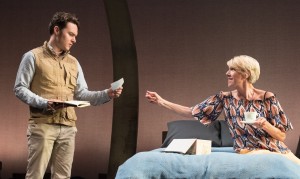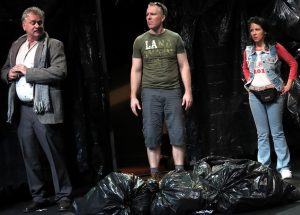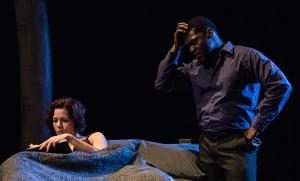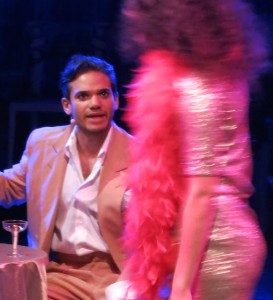MJ Kaufman’s latest play, Sagittarius Ponderosa, tells the story of a young man returning home to help take care of his ailing father. The play, staged by the National Asian American Theatre Company (NAATCO), begins at a Thanksgiving dinner with the young man, his father and mother, and his grandmother expressing what each is grateful for. This opening scene is telling. On one hand, it’s a precursor to many familiar stories: a young person returning home attempting to make his way in the world, and his struggle with sexuality, love, and attachment; a child taking care of an elderly parent; a wife coming to terms with the eventual death of her husband; a grandmother’s struggle with hearing issues, and, more important, her desire to see her grandchild married. Even though Kaufman sets Sagittarius Ponderosa squarely within an Asian-American family, each of these stories is universal.
tick, tick...BOOM!
For the late Rent composer Jonathan Larson, the “tick, tick, boom” in his head were the sounds signaling the passage of time as he matured and yet struggled to achieve success in the theater. Although Tick, Tick… BOOM! was originally written as a highly autobiographical solo piece, it was reworked after Larson’s death and the success of Rent to include two more characters, a girlfriend and a roommate. Fans of his 1996 hit rock musical are likely to thoroughly enjoy the Keen Company production of Tick, Tick… BOOM!
Is Now Really the Time?
Any time theater requires backstory and more research after the curtain drops, it dances a fine line between “Wow, that was interesting. I want to know more” (if you’re lucky) and (more often than not) “What the hell did I just see?” Little Lord is a Brooklyn-based company whose previous works have been praised as “scrappy creative brilliance” or “fearless in ... weirdness.” Now Is the Time. Now Is the Best Time. Now Is the Best Time of Your Life is its latest undertaking, and the show clearly falls in the second category—fearless and weird.

The Little Lord production team sets the tone for a fun and crazy evening with free pickles and coleslaw, offering $4 beer by folks dressed like deli workers and a Mistress of Ceremonies, straight out of Hairspray, even before the “curtain” goes up. Truth be told, the only thing that resembles a curtain is an iridescent panel of foil strips at the back of the stage. Just in time for Halloween, Now Is the Time is a perfect occasion to reimagine Washington Irving’s story of Rip Van Winkle, provided you are one of the few who remembers it! Between the Diedrich Knickerbocker character, a Rip Van Winkle character (oddly, played by a woman), six actors dressed up as freaky yard gnomes, and that Mistress of Ceremonies in a lime-green, pleated baby-doll dress (who later appears as Beelzebub), there is still never enough story to know which end is up. The six yard-gnome characters, who appear as if to taunt Knickerbocker, often repeat lines in unison from some of Knickerbocker’s books. Near the end, they return in white clothes and colorful knee-high socks, sporting black dunce caps (Karen Boyer did the wildly eccentric costumes) and carrying small, wooden children’s chairs. It is all just odd and disjointed.
The set design by Peiyi Wong resembles something out of Hoarding: Buried Alive on The Learning Channel. Stacks and stacks of books, a mountain of lawn chairs and beach balls, leftover Christmas lights, and an old library card catalog are just a few items that fill the stage. If you knew how Irving came to create the Rip Van Winkle character—who slept through the American Revolution—to somehow figure out this Rip Van Winkle awakens in the Catskills somewhere near Grossinger’s, the set might make sense. Now Is the Time has a mountain of missing information, and one more prop isn't going to help.
Director Michael Levinton, who also takes on the lead role of Knickerbocker, has a vision for Now Is the Time that never quite translates across the footlights. As Knickerbocker, he is outrageously quirky, and his delivery engaging. Written by Levinton, Laura von Holt, and Little Lord, the play tosses out interesting snippets of New York history like popcorn, but the story never develops beyond witnessing the madness of a man who dresses like a homeless King George, his nonsensical interaction with Rip Van Winkle, or his hiding from his loud, obnoxious wife who looks more like she should be singing, “Welcome to the ’60s.”
Now Is the Time features Kaaron Briscoe, David GR Brummer, Avi Glickstein, Fernando Gonzalez, Sauda Jackson, Polly Lee, Ry Szelong, and Morgan Lindsey Tachco. Each of them thoroughly embodies the characters they were given, whether they are the deli workers, freakishly odd garden gnomes, or the Children of the Corn with dunce caps. The full production includes very good sound effects by Kate Marvin, along with eerie and complex light design by Marika Kent.
If you are a devotee of Little Lord and company, Now Is the Time may be the ticket to be had. However, without more backstory and some continuity, it’s going to take a lot more than pickles and beer to clear the haze, wicked garden gnomes notwithstanding.
Now Is the Time. Now Is the Best Time. Now Is the Best Time of Your Life plays through Nov. 5 at the Abrons Arts Center (466 Grand St. at Pitt Street) on the Lower East Side. Evening performances are at 7:30 p.m. Wednesday through Saturday; matinees are at 2:30 p.m. Saturdays. Tickets are $25. For tickets and more information, visit abronsartscenter.org.
Who’s the Fool?
There are only so many ways to describe the Jessica Scott's avant-garde Ship of Fools, currently at HERE Arts Center. On the one hand, it is a unique combination of original music, puppetry, video, and live action, yet on the other it comes across as disjointed and meaningless—imagine Disney’s “It’s a Small World” born in the 1960s Haight-Ashbury. The audience is seated on a platform that moves left or right, and sometimes rotates completely, giving the performers time to set up the next vignette on the perimeter.
One Man’s Treasure
As the saying goes, “One man’s trash is another man’s treasure.” So it is in Storage Locker, a black satire riffing on A&E’s reality show Storage Wars. Written by Jeff Stolzer, the play is often quite funny, with expressive banter between a husband and wife who secure the winning bid on an abandoned storage unit. Stolzer is a clever writer. In Storage Locker he develops interesting and layered characters, intricately weaving them into shifts in time. Bryn Packard and Nicole Betancourt, who play the husband and wife, deliver the dialogue with velocity of a couple that have been together for awhile. Stolzer easily takes them from ridiculing each other to playful and loving in a blink. Betancourt is smart and sassy, a diminutive “spitfire” to Packard’s “I’m the provider, I make the decisions” husband. They are believable and engaging.
Director Julián Mesri invests the script with a tempo that draws the audience in. With a video camera on a tripod and monitor, soon enough it becomes evident that the pieces of masking tape on the floor are marks to make sure the actors are in the sight line of the camera for television production. Reality television has little to do with reality, after all. Here, the audience is inventively caught between observing the actors on stage and through the monitor. Betancourt and Packard have a great time playing to the camera; their chemistry is contagious. Mesri’s use of the stage, including the sound booth and emergency stairwell, as well as video camera equipment, helps creates a comic romp through one man’s trash.
Also watching the monitor is an older man seated with his back to the audience. He fiddles with a Rubik’s Cube. In time, the older man (David Crommett) enters the fray, wanting to purchase the storage unit from the husband and wife. He claims he was late to the auction because of a doctor’s appointment. Crommett plays the character in the manner of a master manipulator. He toys with both the husband and wife, luring one with his tales of woe and the other with the wisdom he has developed over 30 years of choosing which storage units pay off. That might be a Picasso behind the trunk. Again, the fun of Mesri’s direction is watching the actors running to the sound booth as if to engage the television producers for direction or utilizing the camera as a handheld and chasing the old man.
Stolzer’s script, with an ample amount of intrigue, and Mesri’s keen staging keep everything moving smoothly until the last five minutes, when it all just sputters. Oddly, with everything that’s going for it, the play devolves at the very end into a confusing “fade to black” puddle. Even the actors, who until this point were spot on, appear lost. Throughout the play the storyline arches and pulls back, reels and sways, and then, suddenly, it’s as if someone lost the last two pages of the script—65 minutes of witticisms, laughter, cajoling, and get-rich-quick banter followed by five minutes of “What just happened?”
The set design by Warren Stiles looks all wrong, and a simple site visit to Gotham Mini Storage should have been required. Instead of a storage facility of cement hallways and orange metal roll-up doors, there is only black plastic sheeting, ragged at the bottom where it doesn’t come completely to the floor and light seeps under. Trash bags the characters pull from the storage unit that are supposedly filled with 50 pieces of clothing are kicked around as if they are filled with crumpled paper.
The lighting by Miguel Valderrama appears to toy with the otherworldly, in a Twilight Zone manner, but falls just a bit short. Most likely his efforts would have paid off with an appropriate set, but how does one light a misstep? Director Mesri put together an interesting original score, which included excerpts from Leos Janáček’s first and second string quartets.
Storage Locker is a perfect example of why small theaters are one of the best “play-grounds” for makers of theater. Playwrights get to test their writing skills, directors hone their craft, and actors perfect character development—all for the pleasure of the audience, which gets to bear witness to the creative process. For 65 minutes, or 92% of the time, Storage Locker and its quirky, delicious contents deliver.
Storage Locker can be seen at 8 p.m. Thursdays through Saturdays and at 3 p.m. Sundays through Oct. 30 at IATI Theater (64 East 4th St., between Bowery and Second Avenue). The running time is 70 minutes. Tickets are $30; students and seniors $25. For more information and to purchase tickets visit iatitheater.org/programs/detail/storagelocker.
Tortured Souls
Marta Mondelli’s Toscana, or What I Remember begins as the story of two couples whose lives intersect at a hotel in Tuscany in the middle of February. Each is tortured in his or her own right. It starts interestingly enough with Emma (Mondelli herself), an Italian who has been living in New York, and her husband, Fred (Scott Barton), who is paralyzed from the waist down and confined to a wheelchair. To say they annoy each other is an understatement. Emma, who often hears a little girl singing and playing, is neurotic, bitter, and foul-mouthed. If she loves Fred, it’s hard to tell. “All of a sudden he gets in this stupid chair, and I have to carry him around like a baby in a stroller,” she complains.
The second couple, “Sue and Larry Cole from Wisconsin,” played by Nicole Kontolefa and Lance Olds, add a bit of lightness to the play initially, but not for long. Larry is a botanist visiting Italy for a conference, while the pregnant Sue annoys him by frequently apologizing to him. He detests the phrase “I’m sorry” so much that she ends up apologizing repeatedly, a gag that should have been funny. Though not as unpleasant as Emma and Fred are to each other, the Coles are wound tight. Sue becomes a little unnerved that she’s forgotten her sunblock—even though it’s 50 degrees in February! Larry is concerned about his speech at the conference. “Hopefully, no one will scream at me today,” he says. “Plant scientists are so conservative.” The typical Midwestern characters are written in a way that suggests it’s their first trip abroad.
Kontolefa, however, exhibits a range of emotion. She begins as an awkward young wife, concerned about her pregnancy. But her Sue is either afraid of Larry or afraid of losing him. When confronted with the possibility that her husband and Emma may have kissed, she displays a strength that shows a depth of character, losing any previous hints of schoolgirl silliness.
Director Tara Elliott keeps things moving along smoothly. However, she was not able to elicit from the actors the subtleties necessary to portray Fred and Emma convincingly. Playwright Mondelli was unable to flip the switch from neurotic and mean-spirited to loving and doting for the bipolar Emma. Barton was only able to move off the emotion of exasperation when he had dialogue with Sue about her pregnancy.
Furthermore, Mondelli’s script is underdeveloped. Too many times the conversations come off as inane cocktail conversation and unnervingly repetitive. Emma asks Sue, “How far along are you?” and she replies, “Ten weeks.” Emma retorts, “How many months is that?” Or Larry’s insipid argument that plants don’t respond to music but yet “they communicate to each other through electricity.” When Sue wants to push Fred in his wheelchair, Larry interjects, “Sue, you’re weak.” No, she’s pregnant; since it’s already been revealed that he’s been through one pregnancy with his first wife, why would he jump to “weak” when there is nothing in the script to suggest it?
On the other hand, there are elements that complicate the story that Mondelli leaves undeveloped. For instance, there’s the recurring sound of a child singing offstage—while appropriate to hear the child singing before the play begins, which sets the tone, it makes little sense during the play for the audience to hear the child, given a turn of events late in the production. Although Emma repeatedly swears at the child, which paints her as callous, there’s a persuasive twist that comes too late to redeem her.
Oddly, there is something to Toscana, which is probably what brought it to the stage in the first place. However, it wasn’t nurtured and developed to its full potential, which can happen when the playwright is also cast as the lead. Surprisingly, after all that, the play resonated more the next day than immediately after. Maybe the dust had to settle on too much unfinished, stilted dialogue to get to the heart of Toscana in the moment.
Toscana, or What I Remember is at Cherry Lane Studio (38 Commerce St. in Greenwich Village) through Oct. 1. Performances are at 7 p.m., Tuesday-Saturday; Matinees are at 2 p.m. Sept. 25 and 3 p.m. Oct. 1. Tickets are $18 general admission and $15 for students/seniors. For tickets, go to https://web.ovationtix.com/trs/pr/963985. For more information, visit toscanaorwhatiremember.com.
A Midsummer’s Nightmare
Luckily for dramatist Elda Cusick, the director of her new play, Austin, A Summer Night's Dream in Hell's Kitchen, hired very good actors; they are the saving grace for a rambling and extremely shopworn script. It is truly unfortunate that Cusick’s muddled drama has wasted such talent.
The playwright purports to tell the story of the title character, a middle-aged, recovering addict (Thomas G. Waites), who returns to his family after his seventh stint in rehab. Austin surprises his wife, Petra (Rochelle Boström), and teenage daughter, Dory (Michaela Waites), who are living in Brooklyn. However, he is staying with his brother Martin (James McAffrey) in their childhood brownstone in Hell’s Kitchen.
In rehab Austin has had a relationship with one of the therapists, Andy (AJ Cedeño), who uses gardening as rehabilitation tool. Juxtaposed to this unethical patient/therapist behavior, Dory complains to her mother that her therapist is touching her inappropriately. Petra brushes off the concern with, “That’s called ‘therapeutic touch,’ to comfort you,” but quickly follows it with “You could dress more modestly.”
Austin is riddled with narratives, most which are poorly thought out. Every character is conflicted, and it’s no surprise that Cusick uses the name Pandora for the daughter (“Dory” for short). The only common, if entirely preposterous, theme, is that Austin believes he will return to his wife and daughter. Andy chastises him about his sexual ambivalence: “There’s a lot of guys like you, your age bracket, having problems like you’re having.” Meanwhile, Andy suffers from his own internal conflict and attempts to kiss Dory. Later, Dory admits to her uncle, Martin, who has been having an affair with her mother for years, that she has been having sex with a number of men: François, Pascal, a deli guy, a mechanic, and a policeman, to name a few. She’s pregnant but, shockingly, doesn’t know who is the father.
Whether Austin the play, not the man, could be fixed is entirely questionable. Cusick’s script has a deep distrust of therapists, which is prevalent throughout, and she does not appear to have an understanding of addiction or rehab. With information so readily accessible on the Internet, her lack of knowledge regarding science or the basic concept of linear time is even more striking.
The absurdities are startlingly apparent in a scene in which Dory reminds her mother of the time that she “put the thermometer in the pea soup on the stove to get a high temperature so I wouldn’t have to go to school” and that it broke in the soup, which they subsequently ate. The fact they all survived drinking mercury, when even a minuscule amount is lethal, is utterly confounding—not to mention that nobody noticed the glass in the soup.
Director Ed Setrakian’s staging for the most part is passable. However, he hasn’t helped the writer clear up some of the clumsy storylines, and much of the blame for the play’s failure belongs to him. Set changes are cumbersome and lengthy, and the rooftop scene at the end is played on a high upper level. In the scene Austin finally learns of his wife’s affair with his brother and confronts Marty. They fight, but it loses all impact by the sheer distance from the audience. The hashed and rehashed story of the gay or lesbian dying a tragic death is dated and, frankly, offensive. More so with the additional details that Martin, at the behest of their father, beat his brother brutally when they were children because Austin was thought to be a sissy.
Life may be this messy, but Austin comes off as a ripoff of a film noir interspersed with narratives from a cheap romance novel. Cusick provides little for the audience to latch on to, with themes that are trapped in a time warp. Sadly, even with the quality of the actors, there isn’t a character worth caring about.
Austin continues through Sept. 9 at The Lion Theatre (410 W. 42nd St., between 9th and 10th avenues). Evening performances are Wednesday through Saturday at 8 p.m.; matinees are at 2 p.m. Saturday and 3 p.m. Sunday. Tickets are $59.50 and available by calling Telecharge at (212) 239-6200 or (800) 432-7250 or visiting Telecharge.com.
Revolutionary Relations
A powerful and thought-provoking drama, A Man Like You tells the story of a British diplomat abducted by Somali terrorists and held for ransom for months. Throughout the work, Kenyan-born playwright Silvia Cassini addresses one overarching question: What constitutes terrorism? The piece chillingly delves into a world ravaged by colonization, the plight of the Somalis, radicalization, Islam, the current political scene, and what exactly so many so-called legitimate governments do in the name of democracy and thinly veiled corporate interests. Very little is being referenced in the media about Somalia beyond piracy. A Man Like You is a play to be experienced.
The vast majority of the fast-paced and intricate dialogue, against the backdrop of a distraught wife, is between Patrick North (Matthew Stannah) and his abductor, Abdi (Jeffrey Marc). Andrew Clarke plays a Somali rebel guard.
Director Yudelka Heyer heightens the emotional and often violent physical relationship between North and Abdi. By design, the tension is palpable from the moment North, hooded and gagged, is thrown into the cell and chained to a metal cot. Taunted by his captor, North eventually acquiesces to what seems like his abductors’ only demand—that he sign a letter replacing a company that has been preferred for a government contract, but not after challenging them: “You really expect me to believe that all this is just to remove a single individual who some warlord ‘dislikes’?” If this were the only reason for his abduction, life would be simple, and A Man Like You is not simple.
It is wrenching and skillfully presented, with acting that is complete and detailed. The audience is on two sides of the stage and in some cases sitting at stage level. The smartly designed set, by Christopher Wharton, bifurcates the stage with a windowless cell at the front closest to the audience; behind it, slightly raised, is the living room of the North’s home in Nairobi.
Credit is due Cassini for what must have been exhaustive research, resulting in a script that is as tightly crafted as a century-old Berber carpet. The argumentative dialogue details the plight of the Somalis through decades of colonization, and it becomes clear that they are just pawns in a greater political and well-funded chess game.
Heyer is from the Dominican Republic, a country with its own history of strife and political upheaval. As director, she helps Stannah and Marc deliver a knockout punch that drives their performances to the edge of sanity. They, along with Clarke, realistically play the strongly staged fight scenes. Interjected as counterpoint to the scenes in the cell are the monologues of North’s wife, Elizabeth (Jenny Boote). Boote brings a calculated, reserved British air to her nuanced performance as North’s clearly distraught wife.
Much has been written about the American Revolution rejecting the control of Britain and the monarchy. No doubt the conversation in Britain was about the terrorists commonly referred to as “the colonies,” while on this side of the pond it was considered a revolution. Using the conflict in Somalia as the canvas, A Man Like You rips apart the oft-used language we are quick to label terrorism.
Performances of A Man Like You, presented by RED Soil Productions, are at 8 p.m. Wednesdays-Saturdays and at 3 p.m. Sundays through July 31 at IATI Theater (64 East 4th St., Manhattan). Tickets are $30 and may be purchased by calling (800) 838-3006 or visiting BrownPaperTickets.com.
Sliding into Darkness
The play has been lauded as one of the best English-language examples of the German experience during the Nazi regime. It follows the life of John Halder (Michael Kaye), a professor devoted to his wife (Valerie Leonard) and children who falls in love with a student (Caitlin Rose Duffy). His elderly mother (Judith Chaffee), who can no longer see and suffers from neurotic breakdowns, is institutionalized in a health care facility. She laments often, “What have I got to live for?” Halder has been so moved by her experience that he has written a book on compassionate euthanasia that has caught the attention of the Nazis.
Halder succumbs to the praise the Nazis have foisted on him. Though one of Halder’s best friends is Maurice (Tim Spears,) a Jewish analyst who is well aware of the coming dangers and hopes to get his family to Switzerland, Halder continually tries to reassure him, stating, “...all that anti-Jewish rubbish. Just balloons they throw up in the air to distract the masses.” They use his writings and his work at the university to pressure him to lead a book burning, which he does, asking if he can keep his books.
An underlying popular musical theme provides Halder an Everyman appeal as he shrugs off the propaganda as a passing fad. A longing to belong and the middle-aged man’s desire to avoid his family obligations round out the character. Whatever core beliefs Halder has held are overshadowed by the sheer power of the Nazi machine and the propaganda— “Deutschland Über Alles.”
The overall set design is inventive yet simple—wooden boxes of different sizes that are thrust together or pulled apart to create seating, along with an upright piano that is used to house props. Both are employed by Petosa to create the height, movement, and tension appropriate to the play. The palette for the costumes by Jessica Vankempen seems appropriate for late-1930s Germany. Only the lighting by Hallie Zieselman is problematic. It could be that she is at odds with the house trading off curtain times with the PTP/NYC production of Howard Barker's No End of Blame, but the lighting is sketchy, too often leaves the actors in the dark, and feels like an afterthought.
Frankly, the great challenge for director Jim Petosa’s heart-wrenching revival is the backdrop of politics 2016. The vitriol used to deliver misogyny, xenophobia, and homophobia among so many other divisive tactics being employed by politicians and pundits today makes this play almost pale by comparison. In Good, the horrors of Nazi Germany can be felt in Petosa’s direction of Kristallnacht, with so many good people standing aside. The question is, Can mankind learn?
C. P. Taylor’s Good runs through Aug. 6 at The Atlantic Stage 2, on 16th Street between Eighth and Ninth Avenues. Evening performances are 7 p.m. Tuesdays through Sundays; matinees are at 2 p.m. Wednesdays, Saturdays and Sundays. Good runs in repertory with No End of Blame by Howard Barker; for exact days and times, visit PTPNYC.org. Tickets are $35, $20 for students and seniors and may be purchased by calling 1-866-811-4111 or online at PTPNYC.org.
Number One or Number Two?
Comedy is a tricky commodity. Many a writer, comedian, and movie has gone down in flames, and it would be too simple to say that it’s all in the writing. Yet, even the best comedic writing in the wrong hands can feel flat and lifeless. Satirical, musical comedy is even more challenging. Some of the best theater has been created by a team, adept at pulling and pushing each other to new heights. Here I Sit, Broken Hearted ... A Bathroom Odyssey is written, directed, and stars Seth Panitch with original music by R. Johnson Hall. It chronicles the world of bathroom graffiti and also stars Ian Anderson, Matt Lewis, and Chip Persons.
The set design, by Mike Morin, is a men’s bathroom with four stalls scribbled with graffiti. The back wall above the stalls is used for projection of corresponding graffiti and photos; given the set design, it is difficult to read the visuals displayed and it quickly becomes annoying. The speakers for the music are keenly hidden in the trash receptacles on either side of the stage.
Coughing and shuffling can be heard behind the stall doors and they open to reveal the actors sitting on the commodes. Spoofing “Taking a Chance on Love,” they begin to sing.
Here I go again,
I hear those trumpets blow again.
Me on my throne again...
Taking a chance on love!
Sadly, the comedy of Here I Sit, Broken Hearted never rises above these lyrics; it misses the mark on practically every level. The saving grace, beyond the short 60-minute length, is the pure joie de vivre of the cast, specifically Anderson and Lewis. If the actors suspect that the material isn’t funny, current, or satirical, they never let on. Purely for trying to make it work they deserve kudos. A cameo appearance by an unnamed young woman is quite cute. Thinking she’s entered the women’s room, she walks in to find four white guys rapping. Incredulous, she asks “Were you guys ... you didn’t happen to be—rapping, did you?”
The fault in this piece lays squarely on Panitch. When one is so heavily entrenched in the creative process, it can be difficult to step far enough away from the material to discern what’s really good and what should be dumped. The monkey mind keeps insisting, ‘This is really good.’ This time the monkey lied.
With "South Park" and The Book of Mormon, not to mention countless movies, bathroom humor, full of innuendo and fart jokes, has been done, and Here I Sit, Broken Hearted feels dated. It takes a deft hand and slightly twisted mind to write new bathroom material. The song choices sound as if they are meant for an older audience, as well as the lyrics. Imagine the Catskills circa 1970. Second, it’s unusual to find a public bathroom like this any longer except at the beach or maybe a highway rest stop, so the references are difficult to pull off in 2016 Manhattan. A giant blow-up condom bit, immediately followed by a scene with two giant blow-up penises, is not even sophomoric enough to relish a laugh.
Given the sexual exploits of politicians and bathrooms, Panitch misses opportunity after opportunity, instead choosing to dress two of the actors to look like Donald Trump and Hillary Clinton who have little, if anything, to do with a public restroom. Gilded, maybe, but a public restroom, hardly. Public restrooms are notorious for sex, yet there is little that is sexy about Here I Sit, Broken Hearted.
While the four actors get on and off the toilets they continually wear some form of underwear. There are countless ways to be coy and funny while teasing some nudity, a la the full monty, with sleight of hand or lighting, and it would seem appropriate for a bathroom musical. Instead, they continue to pull up underwear on top of underwear, stopping short of what could have been quite fun.
The icing on this pile is when Panitch recounts a visit to the Western Wall in Jerusalem when he turned 13, seeing prayers stuffed into the crevices between the ancient stones. “So, when I entered that fateful bathroom stall that day, and saw once again that famous refrain on the wall, I was strangely reminded of the Western Wall.” Attempting to correlate one of the most sacred sites on the planet, holding the prayers of the faithful, to bathroom graffiti is beyond a stretch of the imagination and borders on the profane.
Here I Sit, Broken Hearted… A Bathroom Odyssey runs until July 9 at the Beckett Theatre at Theatre Row (410 W. 42nd St. at Ninth Avenue). Performances are Wednesday through Saturday at 8 p.m. and Sunday at 3 p.m. Tickets are $19.25. To purchase them, call 212-239-6200 or visit Telecharge.com.
à la
Consumerism Gone Mad
What would you do to get a home? How far would you go? What if it were free? These are just a few of the questions posed to the audience by Jill and Ollie, a young married couple at the center of Philip Ridley’s sharply satirical Radiant Vermin. If anyone ever thought rampant consumerism is an American phenomenon, look no further. Ridley takes strategic aim at relatively new spectacle in the UK and hits a bull’s-eye.
Playing Jill and Ollie, Scarlett Alice Johnson and Sean Michael Verey, along with the charming and talented Debra Baker, bring Ridley’s hilarious script to life. Jill and Ollie, who have a newborn on the way, intimate early on that they are not proud of what they’ve done, but they have received a letter from the "Department of Social Regeneration Through the Creation of Dream Homes" offering them a free home. The letter invites them to meet Miss Dee (Baker) at their new residence to receive the keys. After much back-and-forth, Jill and Ollie decide to meet her in the rundown, relatively empty neighborhood. Miss Dee arrives and produces the contract from a satchel that is very reminiscent of Mary Poppins’. Although they have concerns about the local homeless camps near the house, they sign the contract.
The antics begin the first night in their new home when Jill and Ollie hear someone in the kitchen downstairs. Ollie, who looks like he wouldn’t hurt a mouse, investigates wielding a brass candlestick. The fight with the intruder, who was rummaging for food, is brutal fun, with Verey showing off a gift for physical comedy: he chokes himself and pulls at his own hair before taking a fatal swipe at the intruder with the candlestick. The actor is affable and charming, yet quick and nuanced. Ollie runs to get Jill and, instead of finding a body, they return to find a brand-new kitchen, “the kitchen we saw in Selfridge’s!” But they quickly learn that “renovating” takes on serious implications.
Ridley is known for examining the darker side of humanity, and Radiant Vermin is no exception. There are few if any props, and yet between the detailed script and superb staging by David Mercatali, it is as if everything described is physically in place. Playing only against a solid white backdrop, Verey and Johnson not only portray their characters but also each neighbor as the houses begin to fill up around them and the “keeping up with the Joneses”-type conversations with the neighbors, about furniture and lighting, gardens and automobiles, builds to a mad pace. In order to “remodel,” Jill and Ollie lure more homeless in. The neighborhood becomes a hotbed of consumerism: the “Never Enough Shopping Centre” is opening nearby and their unfettered remodeling begins to tear at the fabric of their souls. Baker reappears as Kay, one of the homeless they have brought home. In a touching scene, she relates the rumors on the streets about people luring the homeless, who never return.
The crescendo, when Jill and Ollie are cajoled into throwing their son’s first birthday party for all the neighbors, is outstanding. Between Ridley’s fantastical writing, Mercatali’s direction, and Verey and Johnson’s acting, numerous neighbors come to life in a frenzy of mime, dialect, and comedic timing. Lighting choices by production designer William Reynolds heighten the frenetic dialogue at the birthday party. If occasionally amid the British accents some of the words are lost, the birthday-party scene is nevertheless priceless.
Verey and Johnson are the heart of this fast-paced black comedy, delivering Ridley’s satiric dialogue. He allows a peek behind the curtain of civility and jabs at human nature. It’s easy to see with Radiant Vermin just how seductive our buying habits become with just a little coaxing. If this is the best Britain has to export, long live Brits Off Broadway.
Radiant Vermin continues at 59E59 Theaters (59 East 59th St., between Park and Madison avenues) through July 3. Evening performances are at 7:15 p.m. Tuesday to Thursday and at 8:15 p.m. Friday and Saturday; matinees are at 2:15 p.m. Saturday and 3:15 p.m. Sunday. Tickets are $35. To purchase tickets, call Ticket Central at (212) 279-4200 or visit www.59e59.org.
Define Liberated
It’s difficult to get excited about six straight, homogeneous women sitting around in a weekly support group in Brooklyn eating Chinese, drinking wine, and going on about work, men, and sex in the age of Tinder. Imagine watching The View—add food, wine, and Zumba but without an ethnically diverse panel or politics and you’ve got a gist of #liberated, playing at the IRT Theater in Manhattan. Conceived and written by Lillian Meredith, who is one of the actors, the play is created by an ensemble of artists known as The Living Room, dedicated to creating work about contemporary American women.
#liberated starts out relatively innocuously. The “Sister Support Group for the Daily Trials of Being a Woman,” a.k.a. W-I-P-E (an acronym which is never explained), meets weekly and begins each meeting with a fast and crazy video on learning Zumba moves. This week one of the members has invited another woman to join them without asking the group first. The women seem to be put off by someone new inhabiting their “safe space,” but they soon acquiesce. They pour her a generous mug of wine as if to symbolize acceptance into the tribe. The topic this evening starts out smartly enough about the sexual exploitation of women in advertising, and the conversation devolves into who watches porn and who doesn’t. Over the next few meetings the women decide to bring samples of porn that each likes to share with everyone, and the reactions to one another’s choices are quite funny. Then they get the idea to create a more feminist version of porn, with each creating a scene to be acted out and videotaped. Realizing that this may actually empower and liberate other women, they upload the finished product to the Internet with one swift click.
The video takes off—like after like, share after share—that is, until the Internet trolls, hiding behind avatars and fake names (probably sitting in the dark in their underwear in their parents' basements) come out of the woodwork. The scene is similar to watching celebrities read mean tweets about themselves. The trolls are horrific, one wishing they would “drink bleach and die” and another spewing, “I’m ready to pump GENIUS level sperm into your football-shaped body.” The women lose focus on their original intent and create a new set of sexual videos trolling the trolls. Nothing good comes of it, and the play turns extremely dark.
#liberated is codirected by Rachel Karp and Jaki Bradley—it’s almost as if one directed the first half and the other directed the second. There are some good comedic moments early on, although not sustained, and it’s easy to see that the women enjoy being with one another. Dancing to Enya with multicolored scarves to simulate an undulating vulva is actually a pretty funny moment. However, there is nothing sexy enough nor hardcore enough to warrant the vitriol foisted on them by the Internet trolls. The sexual scenarios mostly come off as silly and tame, which begs the question, why the backlash? These are women who most likely would have experimented in college. They know of PornHub and Max After Dark, but beyond that the script lacks imagination and daring.
As an ensemble piece, #liberated includes Tamara Del Rosso, Zoë Sophia Garcia, Lillian Meredith, Gabby Sherba, Taylor Shurte, and Madison Welterlen. They are good enough, given a marginal script. The Brooklyn apartment set design by Frank Oliva has an Ikea look, which includes nice lighting credited to Scot Gianelli. The sound design by Ben Vigus is across the board and oddly employs misogynistic rap music between the scenes. Vigus evokes Internet sounds, television newscasts, and lively Zumba-type music.
In the world of oversharing on the Internet, between Facebook and every social media app, #liberated seemed to want to say something profound. Unfortunately, it never says enough. It does not include women of color or create a powerful, lasting conversation. In a year where we may see the first female president in this country, it’s way past time for women to step up and truly make a difference in the world for women. At best the only message here is don’t engage in a battle on the Internet—no one ever wins.
#liberated runs until June 19 at IRT Theater (154 Christopher St., 3 Floor, #3 B) in Manhattan. Performances are Wednesday through Monday at 7:30 p.m. Tickets cost $18 and are available at rttheater.org.
Cognitive Dissonance
So much has been written about elephants—their vast capacity for family and emotions, as well as the horrific plight of being hunted and maimed for the ivory—that it’s easy to see why Jakob G. Hoffman chose this magnificent species as a subtext for his play, A Persistent Memory. It is the story of a young, wealthy philanthropist, David Huntington (Drew Ledbetter) attempting to make sense of his issue with time and lapses of memory. Elephants and memory—two things that have a long association.

There are numerous threads of the plot that transcend time in David’s world, one where he is never without his journal. It’s difficult to know whether David journals because he’s continually trying to make sense of the difficult losses he has experienced or as an antidote to his self-diagnosed early-onset Alzheimer’s. His addiction to sugar pills to calm his nerves doesn’t appear to help. While in Uganda he meets Olivia (Victoria Vance), a middle-aged, UNICEF worker from Belgium. David’s Ugandan friend from boarding school (Richard Prioleau) has called ahead to introduce them. She tells him of new, strange behaviors by the local elephants and alludes to events that have happened in his life, which makes David uncomfortable. Regardless of what she has been told, she is attracted to him.
Elijah’s girlfriend Carly (Claire Warden) is a concert violinist with a drug problem, and while it seems they have had intense sexual relations, those have now dwindled, to Carly’s annoyance. Kasem (Ariel Estrada), a Thai man and elephant expert, is soliciting funds from David’s family foundation. He is easily angered when David mispronounces his name—it’s KAH-sam—and he walks with a limp that is never explained. Lastly, Marie (Lisa Bostnar) is the fiancée of the elder (unseen) Huntington. She wants father and son to move on from the tragedies that have upset their lives.
Hoffman attempts to address drug and alcohol addiction; sexual issues, from latent homosexuality to middle-aged crises and affairs; trauma, including murder, suicide, and death; depression; and possibly early-onset Alzheimer’s. Those are just the human issues. Stories of elephants in captivity being abused and the ravages of elephant poaching are woven throughout.
Hoffman’s non-linear approach to memory issues works well—“I thought I had already been there”—to show the nagging thoughts plaguing David. Being totally present in any situation is difficult for him. However, because none of the story lines is linear, they prove so confusing that the ending, when it comes, is unexpectedly abrupt. Both playwright and director allow the script to get lost in an abundance of stories that never dig deep enough into the meaning of existence, a question that also preys on David's mind.
Silly script details torture A Persistent Memory, specifically with regard to David and his dialogue. When Olivia hands him a picture of Lake Victoria, his commentary on Africa is childlike: “I can remember growing up, if someone would mention Africa to me, I would immediately think of Tarzan movies, apes—that sort of thing,” but he never moves into a more learned dialogue about Africa.
The redemption of A Persistent Memory is the talented, diverse cast. It is unnerving to witness Warden as Carly experiencing an overdose, and Prioleau’s subtle delivery of Elijah’s affection for David is moving. As Kasem, Estrada’s devotion to the elephants is heartfelt. Vance’s monologue in the AA meeting talking about her devotion to good vodka, neat, is clear and on point.
As David, Ledbetter shows exasperation with not only himself and others, but his lapses of memory are profound. Director Jessi D. Hill uses the actors well to create a fluid expression of time against David’s memories weaving in and out, but in the end A Persistent Memory still feels like a series of vignettes.
When a play feels like it’s not coming together, it’s easy to hear dialogue that reinforces what’s wrong with the script. In a conversation with Elijah about coming late to Carly’s violin performance, David says, “I know that doesn’t make sense, but it’s like my mind decided to log it away as something that already happened. Like a past memory. Forget it. I know it doesn’t make any sense.” And, too often, neither does A Persistent Memory.
A Persistent Memory is playing through June 18 at the Beckett Theatre (410 W. 42nd St., between 9th and 10th avenues). Evening performances are at 7 p.m. Tuesday and 8 p.m. Wednesday through Saturday; matinees are at 2 p.m. Saturday and 3 p.m. Sunday. There is an additional matinee at 2 p.m. on Tuesday, June 15. Tickets are $49.50. Due to the subject matter, this may be inappropriate for ages 12 and under. For more information and to purchase tickets visit http://www.apersistentmemory.com/
Fine, Blame It on the Woman
August Darnell and Vivien Goldman’s new musical Cherchez La Femme, based on Darnell's 1976 hit song of the same name, opens with “Let’s Dance.” It is rhythmic and hot, and the beat permeates the house. The music is recorded, but the singing is live and jumpin’—the party is in full swing. The scene is 1980s New York, just as Caufy Keeps, played by Isaac Gay, is about to launch a much-anticipated tour with his backup singers, the Lemon Drops. The story is loosely based on Kid Creole and the Coconuts and their extraordinary influence on disco—fusing it with Caribbean, Latin, and a whole lot of Cab Calloway.
The book by Darnell and Goldman follows Caufy from New York, where his girlfriend has left him, as he heads for Haiti. Heartbroken, Caufy skips the tour. Instead he takes his sidekick Stingy Brim (CB Murray), often referred to as “brother,” along with his personal assistant to find her in Haiti.
The plot-heavy story includes a young woman who has been stalking Caufy in New York and announces that she is his daughter from a tryst in Oslo 20 years earlier. The Lemon Drops, furious with his decision, head off on their own to become the toast of Paris. The many threads of the story require a suspension of disbelief—all the events appear to happen within days. Scenes in Haiti and Paris could just have easily taken place in a variety of clubs and heavily ethnic communities in New York.
Other aspects are also less than credible. A scene at Customs in Haiti is superfluous and made little sense in that Caufy’s illegitimate daughter shows up at the same time and is able to sway the argumentative Customs agents. With “Baby Doc” Duvalier in power, he has taken issue with Reagan and the U.S.—the Customs agents are more than happy to take a heavy hand with Americans. Act II opens with an odd cheerleader number that seems to have nothing to do with the story. The mother of Caufy’s daughter has an accent that is anything but Scandinavian, not to mention that, for some reason, she is also in Haiti.
The music is where the juice is, and credit (then, as now) goes to Darnell and Stony Browder Jr. Their commitment to the original style they created for Kid Creole, as well as the additional numbers written, completes the show. Add ’80s-inspired choreography by Kyndra “Blinkie” Reevey, and the energy is palpable. Showcasing the talented Kristina Hanford, the reprise of Cherchez La Femme with the full company brings down the house.
Cherchez La Femme belongs to Gay and Murray. As Caufy Keeps, Gay has the sex appeal, certitude, and chops to carry a musical. Stingy Brim, played by Murray, has the best lines of the show. Yet he seems to be challenged by the 2½-hour run time and too many story lines; hence, his delivery is rushed.
Angie Kristic is the director of Cherchez La Femme and, while it’s evident she brought a lot to the production, some editing of the extraneous stories is needed, along with smoother transitions between scenes and more tech rehearsals. The sound, more than anything, is a problem. There are too few speakers and they are poorly placed, with a heavy bass track producing unbalanced harmonies. For as much work as was put into creating and staging this production, the sound and the vocals deserve better.
Costuming (Adriana Kaegi) is pure ’80s, but a bolder color palette would work better, especially for the Lemon Drops. The baggy, zoot suit style of the period is correct; however, Stingy is in need of a good tailor. The choice of using necklaces as bribes for the Lemon Drops was a mistake given the lavalieres each is wearing, as they were difficult and too noisy to put on. Set design (Aaron Mavinga) is bare-bones and a tad too "high school musical"—spray paint, plastic martini glasses, and a cheesy room divider. The village set in Haiti is on point, but it is so far upstage that the distance from the audience has the actors scrambling to fill the space. The lighting (Joe Beahm) in Haiti is a little too soft, and the disco scenes missing the big ’80s flair; however, the fog is a cool touch in those scenes.
It’s rumored that the French meaning of Cherchez la femme—literally, “Look for the woman”—is sexist, meaning no matter what the problem may be a woman is often the cause. In this case, it’s more the lack of a stronger hand editing and some distance from the material, albeit male or female, to know what to keep and what to let go of. Cherchez La Femme has some really good bones—just a few too many to give it the long run it deserves.
Cherchez La Femme continues in The Ellen Stewart Theatre at La Mama (66 East 4th St., Manhattan), through June 12. Tickets are $35 for adults; $30 for students and seniors either online at www.lamama.org, by phone at 646-430-5374, or at the La MaMa box office: noon-6 p.m. daily.
She Won the Lottery
Originally published as a paperback, Ross & Rachel is a tightly written tour de force for Molly Vevers, who easily modulates between “he” and “she” in this fast-paced drama. Fritz raises a number of questions and challenges about being in a relationship from the moment two people meet and how they interact with others at a party. Imagine a couple, not so much as individuals but as a couple conversing with others, practically talking over each other in side-by-side dialogues.
“How long have you two been together now?”
“You’ve still got that look about you.”
“Did you ever hear how we first met?”
“Right from the first moment I saw her, standing next to my sister, I knew.”
“Not now, honey.”
“Strap yourselves in, you’re not gonna believe this story.”
“They don’t want to hear about that.”
“You guys think that’s good? Tell them about how we got back together. She tells it better than I can.”
Vevers delivers this type of dialogue consistently for nearly 60 minutes. She is quite good in this challenging role, especially as the subject matter evolves into difficult, almost unimaginable events. A number of inquiries are examined and played out. Where does “I” end and “you” begin? Just how much will women often give up to be in relationship? Is it true that any man is better than no man? Does “until death do us part” really mean what it says?
Fritz wrote the male character as a typical guy. However, a revelation of an illness he has leads to a demand of her that seems hugely selfish. But the "Ross" character (those names are never heard throughout the work) doesn't seem written egotistically enough to warrant her acquiescence to his request. Or is she just mad?
Vevers begins the performance dressed only in a white cotton waffle-weave spa robe, holding a cup of tea and sipping from it casually as if to have a chat. Eventually she pours the remainder into the shallow pool she is standing in. She then fills the cup from the pool and proceeds to drink from it three times, spitting out the rancid water each time. Cringeworthy, but to what end? The action yanked the focus from the dialogue.
The design elements don’t help much. The lighting design by Douglas Green don’t live up to Vevers’ performance. Lighting appears as an afterthought—almost nonexistent light and a strand or two of twinkle lights hang overhead. Only at one point was the light dramatic enough to complement the brutal dialogue—when Vevers is lit crosswise, creating two distinct shadows on opposite walls. Alison Neighbor has designed a set featuring a shallow, round, black pool of water—which Vevers never leaves after the first 10 minutes or so—surrounded by eight votives on the floor.
To complete the play, director Thomas Martin has Vevers clap three times. The lights go to black, as if it were the “Clapper” lighting commercial or Jeb Bush begging an audience with “You can clap now.” Cue music. Vevers is too fine an actress and the dialogue too complex to incorporate silly moves and allow for a nonsensical set design—it’s unnecessary and distracting.
Ross & Rachel is strong and powerful, and it demands attention, and Vevers brings the words alive. What is striking is her drive to connect with each audience member, most telling in a monologue about coffee. She has a manner and a presence reminiscent of fine actresses from another era. This is her era, her time.
Ross & Rachel is part of Brits Off Broadway at 59E59 Theaters (59 East 59th St., between Park and Madison Avenues). Performances run through Sunday, June 5. Evening performances are at 7:30 p.m. Tuesday through Thursday and 8:30 p.m. Friday and Saturday; matinees are at 2:30 p.m. Saturday and 3:30 p.m. Sunday. Tickets are $25 ($17.50 for 59E59 members). To purchase tickets, call Ticket Central at (212) 279-4200 or visit www.59e59.org.
Concealed and Revealed
“Camouflage: to be in plain sight, but not to be seen” is the undercurrent of Cal in Camo, about a family dealing with grim challenges. At the heart of the play are a husband struggling to provide for his wife and child; the wife who has little, if any, affinity for her newborn; and her backwoods brother, a man of few words, whose own wife has recently drowned. Given the somber plot, Cal in Camo is often surprisingly humorous, with actors who reach deep to pull out emotionally charged performances.
David Harbour plays Tim, who is languishing in a small Illinois town as a distributor of craft beer. His wife, Cal (Katya Campbell), is a stay-at-home mom. Their arguments may resonate as typical, but the writing by William Francis Hoffman delivers the stories wrapped in a unique casing. Relish the amusing moments, because Cal in Camo is a gut-wrenching play. The topic of Cal’s brother Flynt, his behavior at their wedding two years earlier, as well as his upcoming visit, is fodder for intense, fast-paced dialogue.
When he arrives, Flynt (Paul Wesley) just peels away another layer to the family secrets. However, it’s Wesley’s perfectly stilted delivery of Flynt’s simplistic view of the world that is bold: “You wanna bond with that baby...you take that baby dirty as she is....diaper dirty....you…strip her down...and you strip yourself down…and you get down on the ground you wrap your whole body around that baby….even though you might not know what you’re doin’ at all...that’s nature...nature knows what ta do.... like water knows where ta go...you just gotta let it find you.”
Campbell’s Sybil-like performance is striking; on one hand fighting with Tim, her unmotherly response to the cries of her child juxtaposed with her schoolgirl excitement to see Flynt. The reveal of their mother abandoning them and Cal’s experience in and out of foster homes is telling: “The way I grew up in all those different homes with all those different families...you learn not to want...you keep your eyes in front of you...if you don’t want they can’t take anything away from you if you don’t need they can’t break your heart…but I got caught up in this idea this picture of family this thing you had and I started to believe it.”
Harbour takes Tim's lack of trust to a new, in-your-face level—the performance is solidly Harbour. His sheer size next to Campbell takes on a brutish, commanding figure, and his resentment being dragged to rural Illinois by Cal is evident in every gesture, as well as everything he doesn’t say.
The opening scene with Cal on the floor attempting to pump her breasts of milk feels like it was put there for shock value. In that regard, it steals the thunder from the scene of Cal and Tim fighting about her inability to produce milk, which requires them to purchase formula.
Once Tim arrives home to the family kitchen, complete with sliding door to the backyard, John McDermott’s set design works harder. With Flynt standing on the porch, having just walked out of the kitchen, the set rotates, and he is standing on the back porch. Grant Yeager delivers crisp lighting design and, coupled with sound design by Amy Altadonna, creates the perfect storm scene. Altadonna’s baby cries are spot-on, whether through a baby monitor, from the other room, or coming from the traveling car seat.
Cal in Camo is meant to be uneasy, and director Adrienne Campbell-Holt makes sure of it. The dialogue is fast and the narrative hard, begging to be heard. Living is in the asking and yet being vulnerable to the answers; that’s where the heart grows. For the actors it is evident that they know the material and they listen; even more important, they respond in kind. The camouflage is ripped aside and the human spirit is revealed, bruises and all.
Cal in Camo continues at Rattlestick Playwrights Theater (224 Waverly Place, just west of 7th Avenue) through June 12. Evening performances are Wednesdays-Saturdays at 8 p.m. and at 7 p.m. and Sundays and Mondays; matinees are at 3 p.m. Saturdays. Running time is 85 minutes. For more information and tickets call Ovationtix at (866) 811-4111 or visit www.rattlestick.org.
No Regrets
The world premiere of Rising Circle Theater Collective’s production This Time, written by Sevan K. Greene and adapted in part from Amal Meguid's memoir Not So Long Ago, is an extraordinary example of juggling multiple timelines with exacting deftness. The storylines weave in and through one another, much like a memory comes in and out of consciousness. The underlying theme? A life of no regrets.
Delphi Harrington is brilliant as Amal, an overbearing, ethnic mother, one who professes to want only the best for her child but has a distinct opinion about everything. She exhibits the mannerisms and inflections of an older, well-traveled woman. Salma Shaw as her divorced daughter, Janine, comes to her aid when she has broken her arm bringing her home with her to recover. Janine is attempting to pack up her own home to put it on the market, downsize, and restart her life.
In flashbacks to 30 years earlier, the younger Amal, played by Rendah Heywood, meets a charming man-about-town, Nick (Seth Moore), at a party in Cairo. Heywood is cocktail-party elegant as she employs aloofness to counter Nick’s advances.
Nick: “Alone?”
Amal: “Married.”
Nick: “Happily?”
Amal: “Married.”
Nick: “Unfortunate.”
She eventually succumbs, wanting to be free of the oppression she feels in Egypt, yet comes to struggle with Nick’s life choices.
A scene near the end has each of the four main actors taking a seat at the dining table, eating and arguing across one another, and at times sharing the same line. The actors’ timing is impeccable in this charged interaction, demonstrating a fluidity of movement between decades that brings the play alive.
Amal: “You’re leaving.
Younger Amal: “I’m leaving.”
Nick: “You could use a break.”
Younger Amal: “I said I’m leaving.” Amal: “I said you’re leaving.”
Nick: “Good.” Janine: “Good.”
Younger Amal: “No, Nick, I want a divorce.”
Amal: “And what about me?”
The direction by Kareem Fahmy keeps the action moving smoothly between decades. At times Amal remains onstage, as an observer, while her younger self and Nick interact. In one touching scene she “feels” Nick holding and whispering to her, as if she were the younger Amal, with the younger Amal standing just to the side, also experiencing Nick.
Ahmad Maksoud dexterously plays multiple characters, including an Egyptian shopkeeper; Amal’s son, Hatem; and Janine’s younger love interest, Tom. Together, the cast brings the story of This Time to life using English, Arabic, and French. Their accents are delicious.
Designer David Esler’s set of a house in Toronto circa 1990s transitions easily to an apartment in Cairo roughly 30 years earlier. The Toronto house is split-level with a dining room, kitchen doorway, and entry hall, stairs to a second floor, and a sunken living room. Employing five panels, scenic backgrounds transition from the skyline of Egypt to the coast of Rhode Island and winter in Toronto, gently helping to delineate location and time.
The settings are enhanced by the sound design of Mark van Hare, from the opening sound of Edith Piaf modulating from house music to the distinct sounds of a phonograph playing in the living room. The costumes designed by Sarafina Bush are bold and smart.
Two quibbles. First, although the lighting by Scott Bolman is generally quite effective, it sometimes results in actors’ obscuring one another in shadow. It may be the result of a lack of technical rehearsal, but it can be distracting. Second, the end of the play is abrupt. The ever-giving Janine, whose children have grown and whose husband has gone, is at odds with her purpose in the world. “This is supposed to be my time,” she cries. “What the hell do I need?” The end is meant to feel generational, almost as if passing a baton from a strong woman to another strong woman; Nick’s presence is a distraction.
Too often, it seems, modern playwrights are challenged with creating a strong enough arc to engage an audience for two acts, instead relying on one long act. That is not the case with This Time. Greene’s storytelling is compelling and fresh, with engaging narratives. Piaf may have said it best, though: “As you leave, I can say, no, we will have no regrets.”
This Time is playing through May 21 at The Sheen Center’s Black Box Theater (18 Bleecker St. between Mott and Elizabeth streets). B/D/F/M trains to Broadway/Lafayette stop. For more information and tickets, contact The Sheen Center or visit sheencenter.org.
The Secret's Out
Gorey: The Secret Lives of Edward Gorey is a delicious observation of a well-lived, if secret, life that is easily enjoyable even if one hasn’t heard of the subject. A writer, illustrator, and animator who is best known for his macabre cartoon books for children, such as The Doubtful Guest and The Unstrung Harp, and the opening graveyard credits of the PBS series Mystery!, Gorey left a treasure trove of ephemera and memorabilia when he passed away in 2000. Drawing from 1,074 items in Gorey’s home, writer and director Travis Russ has crafted an engaging script, assembled a trio of charming and vibrant actors and a production team that bring to life a vision of the artist, brimming with creativity.
Phil Gillen, Aidan Sank, and Andrew Dawson play Gorey at three stages of his life: in his early 20s after college, in his late 30s, and just before his death, in his mid-70s. They interact easily with one another and occasionally break the fourth wall to address the audience. Although the dialogue carries an undercurrent of “What would you tell your younger self?” it has much more to it.
In one instance, it’s clear the older Gorey (Dawson) knows the answers to the younger Gorey’s query but won’t say, leaving the younger version (Gillen) visibly shaken. In the moments where the older Gorey relives events from earlier days, Dawson shines. Sank, the middle-aged Gorey, delves into the collection of vintage postcards of dead children with curiosity and deference. What is unique about the actors is that all three share similarities, including mannerisms and inflections. However, each delivers the attributes of the character in keeping with his period of Gorey’s life.
Russ and Carl Vorwerk, who designed the set, fill the intimate space with memorabilia, creating an atmosphere in keeping with Gorey’s collecting habits. Three tall, open-shelving units are filled with leather traveling cases, LPs (including Balanchine, a Gorey favorite), a Harvard scarf, and a myriad of notebooks. The back wall is complete with hundreds of 8½” x 11 sheets of paper with Gorey’s drawings and writings.
There is a moment or two near the end where Gorey falters and seems unsure where it should end. The scenes and transitions linger a little too long, and it’s evident that the play is winding down, but when? Having used a voice-over interview previously, the use of it again seemed redundant for the finale.
For the greater part of the evening, Gorey is smart and cleverly crafted from the things the quixotic artist left behind. Gillen, Sank, and Dawson make the absolute most with the great material provided, as well as one another, in a well-equipped playground. Even seated with their backs to a third of the house, they never forget the audience, engaging them at every turn. The young Gorey enjoys one of the best lines, “You know, my friend Ted Shawn, the choreographer—he used to say, “When in doubt, twirl.” Gorey never has to resort to twirling.
Gorey: The Secret Lives of Edward Gorey is playing at HERE, 145 Avenue of the Americas through May 22. (Entrance is on Dominick Street one block south of Spring Street.). Take C/E trains to Spring Street stop. Tickets are $18, For more Information and tickets, visit www.LifeJacketTheatre.org or here.org, or call 212-352-3101.
Bodily Functions
What’s odd about Body: Anatomies of Being at the New Ohio Theatre, is that, as much as it wants to break the audience out of being shocked by nudity, the script doesn’t measure up. The dialogue goads the audience to be comfortable with the body and all of its functions, “Wake up. Fart. Pee. Blow nose while pooping. Burp. Yawn. Drink water. Burp. Cough. Blow nose. Pick at clogged hair follicle under right arm. Burp.” But seriously, to what end? When all the actors have plucked and trimmed their pubic hair to a landing strip, are you really that comfortable with the body? A number of challenges steer this production off purpose.
No Words…
The thing most everyone loves about birds is their ability to fly, yet one of the first things we do is catch them and put them in a cage. The same can be said of love. Told without a single spoken word, Butterfly, currently at 59E59 Theaters, unwraps a story of a kite-maker who is courted by a customer but is smitten with a butterfly catcher. The hour-long production is rich with symbolism, European and Asian sensibilities, and movement choreographed to haunting original music.

































